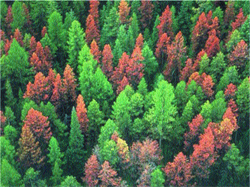 An old
adage says that if the winter is mild, bugs such as flies and gnats will survive,
and the next summer will be particularly buggy. New research is essentially
confirming that scenario, but with greater potential consequences: If Earth
continues to warm, especially in northern latitudes, insect outbreaks are more
likely to occur, and potentially harm forests and affect the planet’s carbon
cycle.
An old
adage says that if the winter is mild, bugs such as flies and gnats will survive,
and the next summer will be particularly buggy. New research is essentially
confirming that scenario, but with greater potential consequences: If Earth
continues to warm, especially in northern latitudes, insect outbreaks are more
likely to occur, and potentially harm forests and affect the planet’s carbon
cycle.Warmer winters in Canada and Alaska have led to an increase in insect outbreaks that damage and turn the leaves of trees brown — often killing the trees themselves — according to new research. Courtesy of Christopher Potter.
In western Canada and southern Alaska, winters have tended to be somewhat warmer and spring has come earlier in recent years, says Christopher Potter, a scientist at NASA Ames Research Center in Moffett Field, Calif., who with colleagues has compiled a dataset of climate and forest cover over the past 25 years. Following anomalously warm winters, satellite images showed a significant reduction in leafy vegetation cover, or the “greenness factor,” Potter says, which is counterintuitive because warmer weather is usually considered better for plant growth.
But significant and sustained decline in greenness (over a growing season or longer), as was seen in Canada and Alaska from 1999 to 2000, Potter says, usually indicates a disturbance, such as a fire, drought or insects. Unusual back-to-back years of warm winters provided a perfect environment for a bug explosion, as he described at the annual meeting of the American Geophysical Union in San Francisco in December.
To test whether or not the insect outbreaks were the culprit in the greenness reduction, the researchers then “groundtruthed” through higher-resolution satellite images, aerial photography and anecdotal evidence from experts on the ground in the locales experiencing the disturbance. According to people living in the area, there was a serious outbreak of pine beetles (which bore through the bark) and spruce budworms (which fed off the stems of leaves on trees, turning leaves brown). “This is the single biggest disturbance event we have seen on a continental scale during the 1990s,” Potter says.
It is possible that these disturbances could be part of the normal cycle of life in forests, Potter says, but scientists do not have enough data yet to say for certain. The disturbances, he says, “could also be an indication or early warning of something very big that’s happening in the climate.”
Looking at greenness cover via satellite images truly is a great way to quantify the disturbances and loss of forests, says Philip Townsend, an ecologist at the University of Maryland Center for Environmental Science in Frostburg, who has been using remote sensing to track defoliation of forests in the Appalachian Mountains by gypsy moths. It is interesting, he says, to look at climate and outbreak patterns — “we know there is definitely a relationship there.”
Two of the major factors that affect insect dispersal and the resulting insect outbreaks are climate and landscape pattern, “for example, patterns of forest species composition and management,” Townsend says. “I think we’re at the point where we can map impacts of specific insect activities through remote sensing. Then we can look at climate data and study spatial distribution patterns, and finally use those data to develop forest and pest management strategies to alleviate some of the damage” and save some affected forests. The loss of forests, Potter adds, can lead to an even larger problem — a lack of trees to soak up carbon dioxide from the atmosphere.
Currently, Potter and Townsend are each working on studies to quantify the loss of carbon sequestration in forests from defoliated trees. And, Potter says, they are trying to put together datasets from a greater number of sources spanning the globe over a longer time period.
Megan Sever
Back to top

